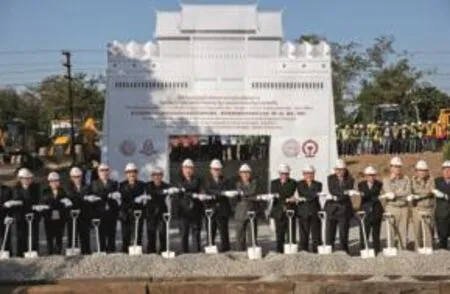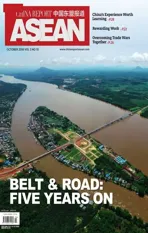CONNECTING THE DOTS
2018-11-05ByWangFengjuanShiGuang
By Wang Fengjuan, Shi Guang
The clear benefits of becoming a hub for Southeast Asia makes cooperation with China a no-brainer for Thailand
In recent years, China and ASEAN have reached consensus on building a community with a shared future. Within the framework of the Belt and Road Initiative (BRI) and Lancang-Mekong Cooperation (LMC), Thailand and China have interacted with each other frequently in various fields. At this new stage of development in the new era, how will China and Thailand seize opportunities for mutually bene ficial cooperation?
“China will contribute Chinese wisdom and Chinese solutions to subregional governance and work with Thailand as a reliable partner to work through any difficulties.”
As of June 2018, Chinese enterprises have invested US$5.4 billion in Thailand.Chinese investment in infrastructure in Thailand has reached US$27 billion, with achievements in tire, photovoltaic industries and industrial parks as standouts.
Physical and Institutional Connectivity
Thailand is an important ASEAN member state,an important LMC partner and key member in the BRI circle of friends. Since Sino-Thai diplomatic relations were established 43 years ago, the two countries have witnessed booming all-round friendship and cooperation marked by deepened political mutual trust, strengthened economic and trade ties and closer people-to-people exchange.
“China will contribute Chinese wisdom and Chinese solutions to subregional governance and work with Thailand as a reliable partner to work through any difficulties,” declared Ren Yisheng,Chinese Consul General in Chiang Mai, Thailand,at the Second International Conference on Belt &Road Initiative and Lancang-Mekong Cooperation:New Era and New Start, held in Chiang Mai on September 19, 2018. Ren noted that friendly Sino-Thai relations are emblematic of construction of the LMC and BRI. All the cooperation partners should adhere to the Silk Road spirit of peace and cooperation, openness and inclusiveness, mutual learning and mutual bene fit to improve not only physical connectivity of infrastructure, but also institutional connectivity in policy, rules and standards, narrow the development gap, increase momentum for development and share in the dividends of cooperation.
Zhang Jiuhuan, former Chinese Ambassador to Thailand and member of the Advisory Committee of the Chinese Ministry of Foreign Affairs,described China-Thailand relations as “kith and kin connected by a river and a road.” He believes China’s cooperation with northern Thailand in various fields is a microcosm of the booming relations between the two countries. As reliable LMC partners, China and Thailand should leverage their strengths in political mutual trust and complementary economic aspects as they pursue common development. He believes that their joint efforts will set a fine example for building a community with a shared future for mankind in Asia and the world at large.
Emeritus Kasem Watanachai, Minister of the Privy Council of Thailand and Chairman of the Council of Chiang Mai University, said at the international conference that he hopes that implementation of the BRI and LMC will create more opportunities for cooperation between Chinese and Thai entrepreneurs, investors and builders, and more room for exchanges and mutual learning between relevant countries and regions.
Prajuab Kantiya, Deputy Governor of Chiang Mai Province, stressed at the same event that his province, the largest in northern Thailand and second largest in Thailand, is an important development center for the northern region and the nation. Implementation of the BRI is helping ASEAN nations become better connected. Located at an advantageous geographical location, Thailand serves as a central junction among all signi ficant trade and economic routes within the ASEAN region—both the East-West and North-South Economic Corridors pass directly through Thailand.Recognizing the potential domestic bene fits of the BRI, Thailand welcomes the opportunity to become a hub of logistics, tourism and trade.
Niwes Nantachit, President of Chiang Mai University, said at the conference that the BRI is a response to the region’s demand for more and better infrastructure. As one of the world’s largest economies, China is strengthening its role in the development of the Southeast Asian region by implementing various strategies that offer many bene fits to ASEAN countries.
Combined Strength
This year marks the fifth anniversary of the introduction of the BRI. Over the past five years,the initiative started sprouted from words to quickly become rapid concrete progress, yielding impressive results beyond every expectation.It achieved a great leap from theoretical vision to innovative practice and maturation into a new model for pragmatic cooperation in a comprehensive manner.
In recent years, bilateral trade between China and Thailand has grown steadily. For five consecutive years, China has remained Thailand’s largest trading partner and Thailand’s third largest source of investment. Thailand is China’s third largest trading partner in ASEAN. As Thailand resumed its steamship export of frozen chicken to China via the Mekong River, the huge potential for tourism and logistics cooperation between the two countries on the waterway has bec0me apparent.As of June 2018, Chinese enterprises have invested US$5.4 billion in Thailand. Chinese investment in infrastructure in Thailand has reached US$27 billion, with achievements in tire, photovoltaic industries and industrial parks as standouts.

Thai Prime Minister Prayut Chan-o-cha (center) attends the groundbreaking ceremony of Thailand’s first high-speed railway from Bangkok to Korat in Pak Chong on December 21, 2017.

A Thai cook shows visitors the ingredients of hot and sour soup at the 2017 South and Southeast Asia Commodity Expo and Investment Fair in Kunming, capital of Yunnan Province in southwestern China.
The inauguration of the first phase of the China-Thailand Railway (Bangkok-Korat) marked a new day for regional connectivity. By early December 2014, substantial progress had been made on construction of the railway by the time Thailand’s National Legislative Assembly approved a draft MoU on Thailand-China railway cooperation.In late December 2017, construction of a railway connecting Kunming and Bangkok officially kicked off. The line is expected to begin service by 2021.The railway will be Thailand’s first standard highspeed railway. “We are finding better opportunities for development from the cooperation with China,”commented Thai Prime Minister Prayut Chan-ocha.
Thai Minister of Commerce Sontirat Sontijirawong observed that Thailand and China have designed similar development strategies,namely, “Thailand 4.0” and “Made in China 2025,”both of which emphasize innovation and digital transformation. Since 2016, the Thai government has made every effort to promote “Thailand 4.0,”which has a lot in common with the BRI. Thailand and China have wide complementary space in the field of economic development. Effective alignment of the strategies will further promote mutually bene ficial cooperation between the two countries and multiply the bene fits.
Zhuang Guotu, President of the China Association for Southeast Asian Studies, believes that alignment of development strategies will provide a new fuel for the development of bilateral relations. He thinks China-Thailand relations have entered a golden age, with steady growth of trade and investment between the two sides and frequent official and private exchange.At the same time, China-ASEAN cooperation has become a driving force in China-Thailand cooperation.
With the expansion of infrastructure such as high-speed rails, airports and seaports, Thailand intends to develop its eastern provinces into the Eastern Economic Corridor (EEC), a leading ASEAN economic hub of high-tech industry including next-generation automobiles and biotechnology. Zhuang believes that the goals of the EEC are highly compatible with BRI’s objective of “infrastructure connectivity,” which is expected to attract many high-tech Chinese enterprises.
